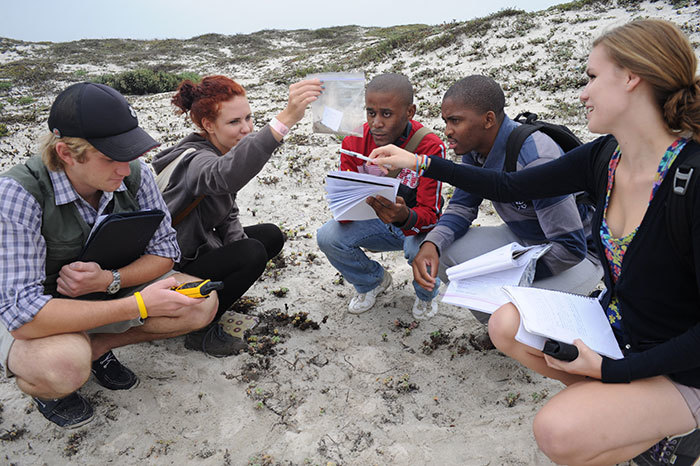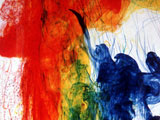Undergraduate research: from the bottom up
25 May 2015 | Story by Newsroom
"Once the research bug bites you, it will never let you go," says deputy vice-chancellor for teaching and learning, Professor Sandra Klopper. She is leading a campaign to encourage research-led teaching at UCT and increase the visibility of undergraduate research.
The purpose, she explains, is to instill in students a love of research from the very start of their studies. "Once this love of research has been awakened, and students go onto postgraduate studies and continue to be researchers, the chances are that they will remain academics."
Klopper was speaking at the launch of UCT's first undergraduate research journal at the Libraries' Research Week 2015. Titled UR@UCT, the journal is part of an institution-wide focus on identifying good practice in undergraduate research and growing capacity for undergraduates to get involved in research projects previously restricted to postgraduate students.
This feeds into the institution's strategy to grow the next generation of academics at UCT.
Undergraduate research is of value to students even if they have no intention of continuing onto an academic career, says quality assurance manager in the Institutional Planning Department, Lisa Cloete, whose department led the campaign to put undergraduate research on the map: "Students exposed to research projects said it had a significant impact on them. They were able to marry theoretical concepts with actual field work and practice, in the process developing the critical skills that are so necessary for a successful economy."
The importance of undergraduate research is well documented in the United States. According to the Survey of Undergraduate Research Experiences (SURE) undertaken at Grinnell College in Iowa, undergraduate students who were involved in research reported a higher tolerance for obstacles, an increased ability to work independently, greater self-confidence, and a better idea of the career path they wished to follow. Of those surveyed, 29% decided to pursue a PhD due to their experience in undergraduate research.
Considering South Africa's shortage of PhD students and up-and-coming academics, this finding in the US is not insignificant.
It may be particularly important for encouraging black South Africans into academia. "Many people who are in academia are not necessarily there because they planned it that way, but because they discovered the joys of doing research while doing a master's degree," says Dr Nelleke Bak, the former director of postgraduate studies at UCT. Currently, fewer black undergraduates than white stay on to do a master's degree. Exposing them to research during their undergraduate courses could be an important tool in transforming the academy.
There are already a number of successful undergraduate research programmes flourishing at UCT. So much so that when it was announced that submissions were open for the first edition of the journal, editors were inundated with responses.
The first edition of UR@UCT includes a range of disciplines and research, including from chemical engineering, commerce and health sciences. These papers will only be fully accessible online by the middle of June 2015.
|
No ears allowed? Profiles of undergrad research As part of her undergraduate research, Robyn Swannack in the Department of Social Anthropology explored attitudes towards the international symbol of deafness: an image of an ear with a line through it. She found high levels of resentment amongst the deaf community.
"A symbol is there to represent something and make people aware in everyday life," says Swannack. "This symbol is used to let others know there are deaf people present. It is used in the medical community to indicate a patient is deaf, and it is used to define deafness." But for many in the deaf community this symbol is ambiguous. The forward slash in signs indicates something is prohibited: think of the no smoking sign. So what does the ear with the forward slash through it mean? No ears allowed? No listening? No hearing people allowed? Swannack undertook a survey of members of both the deaf and the hearing community, and discovered that, while some were neutral about the symbol, many supported it and yet others were offended. For some, the symbol represents a lack of something: one interviewee noted the symbol for blindness is not a set of eyes with a slash through it, nor is the symbol for disability a pair of legs with a line slashed through it. Why then, she asked, is this symbol acceptable for deafness? Recycling textile wastewater "Clothes are not only a basic need but are used to express our personality and personal sense of style," says chemical engineering student Buhle Manana as she opens her presentation on recycling textile wastewater. "The textile industry is one of the largest worldwide, providing employment to 35 million people in India alone."
However, the textile industry also generates a great deal of wastewater. To produce just one kilogram of textiles, around 200 litres of water are required. This wastewater contains dyes as well as salts such as sodium sulphide and sodium chloride that drive the dye into the fabric. "Fortunately," says Manana, "because of technologies and growing pollution awareness globally, wastewater does not have to be disposed of, but can be treated and recycled for re-use." Manana focused on this treatment and recycling process in her undergraduate research. Conventional wastewater treatment techniques use a process of evaporative crystallisation to treat the water. But this treatment technique is not only energy intensive; it is also unable to recover separate salts. The salts formed through this process are then contaminated and cannot be recycled for re-use, but need to be disposed as solid waste. To get around this, Manana's research seeks to use a process called eutectic freeze crystallisation to recover not only the pure water, but also the pure separate salts, at lower energy costs, which can then both be recycled for reuse within the textile industry. When a solution is cooled below freezing point, ice crystals begin to form and rise to the surface, while the salt becomes concentrated in the remaining solution and eventually crystallises. Manana's paper found that it is technically feasible to use the eutectic freeze crystallisation process to recycle textile wastewater more efficiently – a significant finding in a water-scarce country like South Africa. |
Story by Natalie Simon. Main photo by Katherine Traut. Image of International symbol for deafness courtesy of the State of Rhodes Island, accessed via Wikimedia Commons. Image of textile dye mixing with water courtesy of CSIRO, and accessed via Wikimedia Commons.
 This work is licensed under a Creative Commons Attribution-NoDerivatives 4.0 International License.
This work is licensed under a Creative Commons Attribution-NoDerivatives 4.0 International License.
Please view the republishing articles page for more information.












